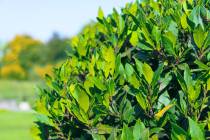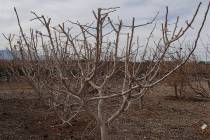Now is not the time to replant Joshua tree in Las Vegas
Q: When is the best time to transplant a Joshua tree?
A: The best time to transplant is in mid- to late spring, but with this plant it could be done in summer as well. The worst times are fall and early winter months. Stay away from these months for planting a Joshua.
The biggest mistake occurs after planting. This mistake is watering too often. Joshua trees are not the easiest plants to transplant mostly because the roots taken when the plant is harvested from the desert are not very extensive.
Select a smaller plant and stake it after planting to keep the roots from moving in the soil and slowing establishment. Plant it the same depth as it was when it was harvested. Another mistake is planting it too deep.
Amend the existing soil with about 25 percent compost at the time of planting. Yes, they are desert plants but they will benefit from improved soils at the time of planting. Water at the time of planting thoroughly and hold off on the water for at least three weeks before watering again.
Water no more than about every three weeks in summer. Less often in cooler and colder weather. It is important for these plants to have dry soil between irrigations.
Q: I have been replacing gravel with wood mulch and I have to put the gravel someplace. What thickness of gravel can I place around the plants, none at the trunk, without causing damage? Also, what is the maximum amount of wood mulch that can be placed around plants without being detrimental to the plant?
A: The depth of rock mulch depends on the size of the rock; the larger the rock used the deeper rock mulch can be applied. Roots need to "breathe," so there must be an exchange of gases between the roots and the air. This happens through the pore spaces in the soil.
Generally speaking, rock mulch is applied somewhere between 2 to 4 inches deep. If this rock mulch contains "minus" material (e.g., ½ inch minus, ¼ inch minus), then apply 2 to 3 inches. If the rock mulch does not contain minus material, then apply it 4 inches or more.
Course mulch without minus material can be applied right up to the trunk. Rock mulch with minus material should not.
Most information out there tells us not to apply more than 3 to 4 inches of wood chip mulch around trees and shrubs. Where this recommended depth came from I don't know, but it is repeated over and over.
I have no problems applying 6 inches of wood chip mulch or more around trees and shrubs provided this mulch is kept away from the trunk of the plant a distance of 12 inches during its first four or five years of growth.
Q: My red tip photinia took a beating this first summer after planting. Should I wait until it is cooler and cut them down to force new growth or replace them?
A: I would wait until the beginning of October. Gently lift them out of the ground, wash the soil away from the root ball, add compost to the soil used when backfilling around the roots and replant them. After replanting them, I would then cut them back to about 6 inches above the soil.
Photinia can handle our hot desert climate with no problems provided the soil is amended with good quality compost at the time of planting. It is important to make sure this plant is not planted deeper than it was in the nursery container.
Photinia does not like rock mulch. Planted in rock mulch, I will give it five years before it starts to look ratty.
You can use the existing native soil when planting them. But you must mix good quality compost with this soil at planting time.
The rootball taken out of the container should not be placed deeper than the surrounding soil. It is very important to thoroughly soak the soil surrounding the plant several times after planting to settle the soil.
When digging the hole for the plant, it does not have to be deep. Dig it deep enough only to accommodate the rootball. It is far more important to dig the hole wide and amend the soil surrounding the roots.
Fertilize photinia once a year in January and use a good quality iron chelate along with your fertilizer at that time.
Q: Please define "deep watering." In particular, how would you describe "deep watering" a pomegranate bush with a 3- to 4-inch trunk?
A: Thanks for asking. I throw these terms around and I assume people know or understand them.
Deep watering is applying enough water in one irrigation so that the entire root system becomes wet. The amount of water needed to do this varies with the depth of the roots. Deep watering is accompanied by less frequent watering. This means giving the soil and roots a chance to dry somewhat before the next irrigation.
There are two ways to water. One way is to give a small amount very often, perhaps daily or twice a day. This supplies water to the very shallow roots and discourages the growth of deeper roots.
The second way is to apply a large amount of water and wait for the plant to use this water before you give more. This is deep watering.
Deep watering is preferable for plants that tend to grow deeper roots. Deep-rooted plants are larger, woody plants such as all trees, all large and medium-sized shrubs, all woody vines and woody groundcovers.
Water deep-rooted plants by applying enough water so that this water drains to a depth of 18 to 36 inches. After reaching this depth, the applied water is shut off until the soil has dried sufficiently. Technically, plants are not watered again until about half of the water in the soil has been used.
When half the water is gone, water is applied again until it reaches the same depth as before. This requires applying the same volume of water at each irrigation. The volume of water applied is the same with each irrigation. The number of days between irrigations changes as the weather becomes hotter in the spring and summer months or colder during fall and winter.
Deep watering normally applies to woody plants but not to lawns, flower beds, vegetable beds and small fruits like strawberries. These are shallow rooted plants and their applied irrigation water is shallow, not deep.
Q: My newly planted pluot tree produced one fruit this past season. I guess I pulled too hard, and the branch where it was attached split. I taped the split back together with electrical tape. When can I remove it?
A: Limbs that have split will never grow back together unless you reattach the broken limbs within a few minutes after the split occurs. Once the crack or split dries, they will never "fuse" back together.
Plants grow around wounds and surround new growth by burying this damage in older wood. If the split occurs in a strategic location that supports the weight of future limbs and fruit, it will probably never be strong enough to support increasing weight in future years.
I don't know how rapidly you got the tape around the wound, but if this happens again, you must reattach the split tightly in a matter of a few minutes. I like to use the expandable green nursery tape that you can purchase from most nurseries are garden centers.
I am guessing the split did not grow back together, is still there and the limb is no longer structurally strong enough to support fruit or the weight of new branches growing from it. Remove the broken branch with the pruning shears and reshape the tree for future growth.
— Bob Morris is a horticulture expert living in Las Vegas and professor emeritus for the University of Nevada. Visit his blog at xtremehorticulture.blogspot.com. Send questions to Extremehort@aol.com.




























